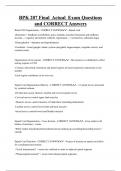Tentamen (uitwerkingen)
BPK 207 Final Actual Exam Questions and CORRECT Answers
- Vak
- Instelling
BPK 207 Final Actual Exam Questions and CORRECT Answers Brain/CNS Organization - CORRECT ANSWER- -Spinal cord -Brainstem = hindbrain (cerebellum, pons, medulla, reticular formation) and midbrain (tectum --> superior and inferior colliculi, tegmentum --> red nucleus, substantia nigra -D...
[Meer zien]




